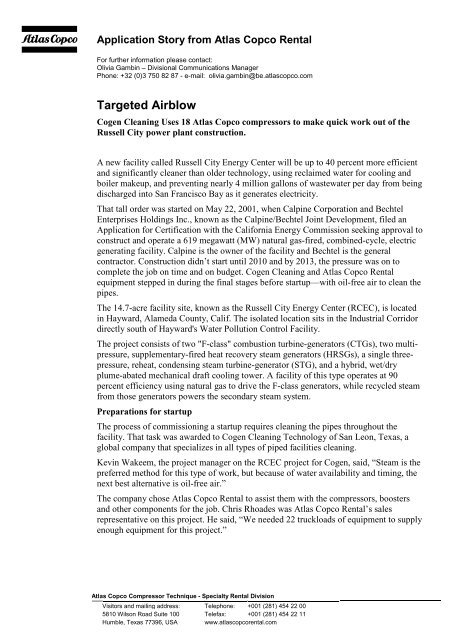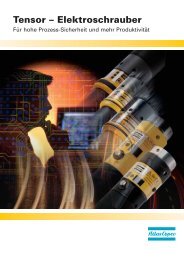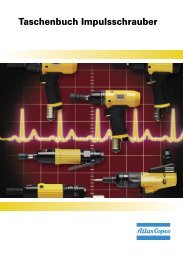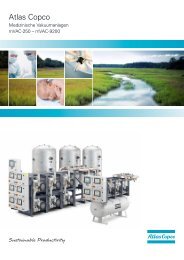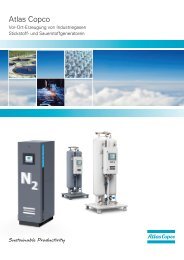Download - Atlas Copco
Download - Atlas Copco
Download - Atlas Copco
You also want an ePaper? Increase the reach of your titles
YUMPU automatically turns print PDFs into web optimized ePapers that Google loves.
Application Story from <strong>Atlas</strong> <strong>Copco</strong> Rental<br />
For further information please contact:<br />
Olivia Gambin – Divisional Communications Manager<br />
Phone: +32 (0)3 750 82 87 - e-mail: olivia.gambin@be.atlascopco.com<br />
Targeted Airblow<br />
Cogen Cleaning Uses 18 <strong>Atlas</strong> <strong>Copco</strong> compressors to make quick work out of the<br />
Russell City power plant construction.<br />
A new facility called Russell City Energy Center will be up to 40 percent more efficient<br />
and significantly cleaner than older technology, using reclaimed water for cooling and<br />
boiler makeup, and preventing nearly 4 million gallons of wastewater per day from being<br />
discharged into San Francisco Bay as it generates electricity.<br />
That tall order was started on May 22, 2001, when Calpine Corporation and Bechtel<br />
Enterprises Holdings Inc., known as the Calpine/Bechtel Joint Development, filed an<br />
Application for Certification with the California Energy Commission seeking approval to<br />
construct and operate a 619 megawatt (MW) natural gas-fired, combined-cycle, electric<br />
generating facility. Calpine is the owner of the facility and Bechtel is the general<br />
contractor. Construction didn’t start until 2010 and by 2013, the pressure was on to<br />
complete the job on time and on budget. Cogen Cleaning and <strong>Atlas</strong> <strong>Copco</strong> Rental<br />
equipment stepped in during the final stages before startup—with oil-free air to clean the<br />
pipes.<br />
The 14.7-acre facility site, known as the Russell City Energy Center (RCEC), is located<br />
in Hayward, Alameda County, Calif. The isolated location sits in the Industrial Corridor<br />
directly south of Hayward's Water Pollution Control Facility.<br />
The project consists of two "F-class" combustion turbine-generators (CTGs), two multipressure,<br />
supplementary-fired heat recovery steam generators (HRSGs), a single threepressure,<br />
reheat, condensing steam turbine-generator (STG), and a hybrid, wet/dry<br />
plume-abated mechanical draft cooling tower. A facility of this type operates at 90<br />
percent efficiency using natural gas to drive the F-class generators, while recycled steam<br />
from those generators powers the secondary steam system.<br />
Preparations for startup<br />
The process of commissioning a startup requires cleaning the pipes throughout the<br />
facility. That task was awarded to Cogen Cleaning Technology of San Leon, Texas, a<br />
global company that specializes in all types of piped facilities cleaning.<br />
Kevin Wakeem, the project manager on the RCEC project for Cogen, said, “Steam is the<br />
preferred method for this type of work, but because of water availability and timing, the<br />
next best alternative is oil-free air.”<br />
The company chose <strong>Atlas</strong> <strong>Copco</strong> Rental to assist them with the compressors, boosters<br />
and other components for the job. Chris Rhoades was <strong>Atlas</strong> <strong>Copco</strong> Rental’s sales<br />
representative on this project. He said, “We needed 22 truckloads of equipment to supply<br />
enough equipment for this project.”<br />
<strong>Atlas</strong> <strong>Copco</strong> Compressor Technique - Specialty Rental Division<br />
Visitors and mailing address: Telephone: +001 (281) 454 22 00<br />
5810 Wilson Road Suite 100 Telefax: +001 (281) 454 22 11<br />
Humble, Texas 77396, USA www.atlascopcorental.com
2 (5)<br />
Wakeem said he has completed dozens of chemical, targeted steam blow and targeted<br />
airblow projects around the world, but only about 10 big airblows like this one. And the<br />
size is significant, about 30 percent larger than the others he has managed. “Typically a<br />
big airblow will be eight to 12 compressors. This project had a total of 18 <strong>Atlas</strong> <strong>Copco</strong><br />
PNS 1250 and XRVS high pressure compressors.” Wakeem said 16 were required at a<br />
time, with the additional two compressors serving as backup.<br />
“We scale a project with one booster for every two compressors for the high pressure<br />
portion of this project,” Wakeem said. They rented nine <strong>Atlas</strong> <strong>Copco</strong> B7-41/1000<br />
Hurricane boosters.<br />
The air must be perfectly clean flowing into the plant, and because the boosters run on<br />
oil-flooded screws, every booster had a coalescing filter pack inline following the<br />
booster. These were also rented from <strong>Atlas</strong> <strong>Copco</strong>.<br />
Although the <strong>Atlas</strong> <strong>Copco</strong> compressors used less diesel fuel due to the FuelXpert <br />
feature, a constant and abundant fuel source was necessary. <strong>Atlas</strong> <strong>Copco</strong> rented 14, 800-<br />
gallon auxiliary fuel tanks for this project. The job was running only 7 a.m. to 7 p.m., but<br />
the compressors could have actually run a full day without having to stop for refueling.<br />
The plan was originally to have two backup compressors, but because of their availably<br />
and tight timeline to complete the project, the plan was changed. Having the additional<br />
air volume of two XRVS high pressure compressors allowed Wakeem to reconfigure the<br />
manifold so the high pressure and low pressure testing could be conducted at the same<br />
time.<br />
“The type of process we use is based on matching the build design specifications with the<br />
air, steam or chemical methods for cleaning. Those are specified by the OEMs for the<br />
components in the plant,” Wakeem said.<br />
Every facility requires a chemical cleaning first. This is a combination of soaps and acids<br />
to remove flux, slag and other residues left by the welding process. Wakeem said on this<br />
job the chemical process was followed by a “hydrolaze” process. “That’s a high-pressure<br />
spray that knocks out debris stuck to the walls of the pipes.”<br />
It was at this point the compressors were brought into the job. In total it took a month for<br />
this airblow project. “The idea is that the customer wanted us to do this on the fast track.<br />
Each of the two high-pressure blows will take a week, the low-pressure systems two to<br />
three days, and the intermediate pressure systems three to four days each. It’s about a<br />
week per system, but we are combining the process to get it done faster,” Wakeem said.<br />
Gregg Alper, President and CEO of Cogen Cleaning said, “CCT has been doing airblows<br />
for years, unfortunately with companies professing to provide ‘oil-free air.’ It wasn’t until<br />
our partnership with <strong>Atlas</strong> <strong>Copco</strong> Rental that we perfected the service and started to<br />
provide our clients the continuity we feel separates us from other service companies.<br />
Choosing <strong>Atlas</strong> <strong>Copco</strong> Rental as our partner in this project was a no-brainer. Our<br />
previous business with <strong>Atlas</strong> <strong>Copco</strong> and particularly Chris Rhoades created the perfect<br />
environment to win this project and serve our customer with the best equipment<br />
available. Chris and his team were critical in securing this project, providing their<br />
expertise all throughout the bid process.”<br />
130416_ASR_ApplStory_Russel Power City USA.docx
3 (5)<br />
Choosing a partner<br />
Selecting the air solution was more than a choice of manufacturers. The extra time<br />
usually associated with renting in a heavily regulated environment was reduced because<br />
of the <strong>Atlas</strong> <strong>Copco</strong> Rental partnership. “There may be no other place more regulated than<br />
California. Choosing <strong>Atlas</strong> <strong>Copco</strong> to work with is a great help. They have gone through<br />
the certification process. They take care of recording and reporting. <strong>Atlas</strong> <strong>Copco</strong> handles<br />
the regulatory problem that is California. If these machines can work in California, they<br />
can work anywhere,” Wakeem said.<br />
Finishing targeted airblows<br />
The process of blowing air to clean the plant’s piping systems consisted of a systematic,<br />
precisely timed routine. Air entered the system in a series of blows. The bank of<br />
compressors produced 20,000 cfm while the boosters increased the 350 psi compressor<br />
air to the required 900 psi.<br />
Wakeem said, “It’s a process. The 900 psi air is released for about five seconds using one<br />
of Cogen’s quick opening valves and the system needs about eight and a half minutes to<br />
recharge. It’s the mass flow of air that pushes debris though the system.” The air was<br />
released at varying pressures to create fluctuation in pressure from 900 to 675 psi.<br />
After this routine, a target was inserted into the line. When sufficient time had passed, the<br />
target was removed and checked for quality of air in the system.<br />
Targets are polished carbon steel plates that have been shined to a mirror finish. After a<br />
series of targets have been tested, the change is quite visible. Targets at first are pitted<br />
and abrasive, eventually giving way to almost clean targets. Wakeem said, “This turbine<br />
manufacturer allows a 0.5 mm tolerance. That’s a mark equal to the tip of a mechanical<br />
pencil – almost indistinguishable. I just keep watching for impacts. When the targets<br />
show repeatedly clean, the process is finished.”<br />
For most projects there are 50 targets supplied. Wakeem said the target process is random<br />
and he reinserts based on knowledge of the system and previous experience. The targets<br />
are expensive and he doesn’t want to waste them either. “It doesn’t pay to put a target<br />
right back in if I know the result won’t change for a day or two,” he said.<br />
This process for the medium and low pressure piping in the plant was done much the<br />
same way.<br />
This project required 18 systems to be blown, each with different lengths of time. For<br />
example, there were five low-pressure systems that took five days total. The first highpressure<br />
system required six days to complete. Wakeem said that a high pressure system<br />
was complete when he got two consecutive clean targets.<br />
Wakeem said that with 27 large compressors and boosters operating over a long period of<br />
time there are bound to be problems. “You go into a project this size knowing there will<br />
be issues. It’s how you deal with those issues that makes for success. We received very<br />
good support from <strong>Atlas</strong> <strong>Copco</strong> Rental that allowed us to continue to make progress for<br />
our customer. That to me is a successful project.”<br />
130416_ASR_ApplStory_Russel Power City USA.docx
4 (5)<br />
All photos are available to download from the <strong>Atlas</strong> <strong>Copco</strong> Multimedia Gallery:<br />
http://multimedia.atlascopco.com/sharesearchentry.jspx?q=russel+city+power+plant<br />
Russel City Power Plant - 03<br />
Russel City Power Plant - 01<br />
Russel City Power Plant - 12<br />
Russel City Power Plant - 04<br />
Russel City Power Plant - 02<br />
Russel City Power Plant - 05<br />
Russel City Power Plant - 09<br />
Russel City Power Plant - 06<br />
Russel City Power Plant - 10<br />
Russel City Power Plant - 11<br />
The setup at Russell City required nine separate groups<br />
of equipment to be piped into the common manifold. A<br />
grouping of equipment included two <strong>Atlas</strong> <strong>Copco</strong> Rental<br />
PNS compressors, an <strong>Atlas</strong> <strong>Copco</strong> B-41 Hurricane<br />
booster, a coalescing filter pack and an 800 gallon fuel<br />
tank.<br />
Getting ready to blow, the power plant is covered in<br />
plastic to protect it from debris and dust shooting from<br />
the plants pipe system. In the lower center, the two<br />
vertical pipes are exhaust vents, the larger vent is for<br />
high and medium pressure air and the smaller for low<br />
pressure. The plant has high, medium and low pressure<br />
rated piping.<br />
(2) Getting ready to blow, the power plant is covered in<br />
plastic to protect it from debris and dust shooting from<br />
the plants pipe system. In the lower center, the two<br />
vertical pipes are exhaust vents, the larger vent is for<br />
high and medium pressure air and the smaller for low<br />
pressure. The plant has high, medium and low pressure<br />
rated piping.<br />
View of the high pressure exhaust<br />
shows both exhausts and power plant but no compressors<br />
On the left, Chris Rhoades is <strong>Atlas</strong> <strong>Copco</strong> Rental’s area<br />
sales manager for California. At the right, Kevin Wakeem<br />
is Cogen Cleaning Technology’s expert on location to<br />
manage the setup and airblow.<br />
To clean the pipes, high pressure air was sent through<br />
the pipes. A polished steel bar called a target was<br />
inserted into the line for the air—and debris—to pass by.<br />
Debris in the line caused damage to a target. Multiple<br />
targets were used over the month-long process to show<br />
the debris was dissipating. Once the target showed no<br />
more damage, the system was proven clean.<br />
These pneumatic plungers insert the target into the<br />
exhaust pipe just before the end of the discharge line.<br />
An advantage of working with rental compressors from<br />
Altas <strong>Copco</strong> Rental is the environmental protection<br />
certification that is secured by <strong>Atlas</strong> <strong>Copco</strong>. Cogen can<br />
focus on the project while <strong>Atlas</strong> <strong>Copco</strong> Rental focuses on<br />
the equipment.<br />
Steve Green is <strong>Atlas</strong> <strong>Copco</strong> Rental main field service<br />
technician onsite. He ensures the equipment is operating<br />
130416_ASR_ApplStory_Russel Power City USA.docx
5 (5)<br />
Russel City Power Plant - 08<br />
Russel City Power Plant - 07<br />
to peak efficiency throughout the project.<br />
L to R: <strong>Atlas</strong> <strong>Copco</strong> Rental field service technicians Steve<br />
Green and Mark Burford, areas sales manager Chris<br />
Rhoades, Gogen Cleaning site manager Kevin Wakeem,<br />
Cogen Cleaning’s technicians Steve Scott and Kenneth<br />
“Captain” Williams.<br />
Cogen Cleaning Technology Site Manager Kevin<br />
Wakeem<br />
<strong>Atlas</strong> <strong>Copco</strong> is an industrial group with world-leading positions in compressors, expanders and air treatment<br />
systems, construction and mining equipment, power tools and assembly systems. With innovative products<br />
and services, <strong>Atlas</strong> <strong>Copco</strong> delivers solutions for sustainable productivity. The company was founded in 1873,<br />
is based in Stockholm, Sweden, and has a global reach spanning more than 170 countries. In 2012, <strong>Atlas</strong><br />
<strong>Copco</strong> had 39 800 employees and revenues of BSEK 90.5 (BEUR 10.5).<br />
Learn more at www.atlascopco.com.<br />
Specialty Rental is a division within <strong>Atlas</strong> <strong>Copco</strong>’s Compressor Technique business area. It serves<br />
customers in various industry segments around the world with temporary air, steam, nitrogen and power<br />
rental solutions. The specialty rental services are offered under several brands. The divisional headquarter is<br />
located in Houston, USA.<br />
Learn more at www.atlascopcorental.com<br />
130416_ASR_ApplStory_Russel Power City USA.docx


